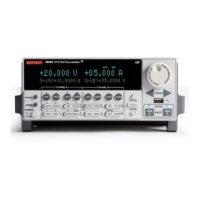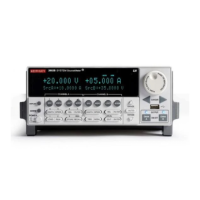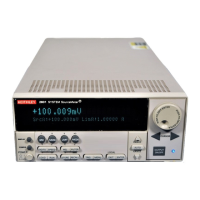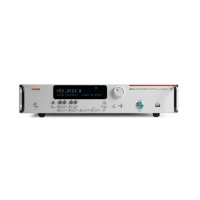2600S-901-01 Rev. C / January 2008 Return to Section Topics E-3
Series 2600 System SourceMeter® Instruments Reference Manual Appendix E: Speed Specification Test Conditions
Single Measurement Rates
The procedure for a Single Measurement Rate test is listed below:
1. A script puts the Series 2600 into a known test state maximizing performance of the
instrument. The script sets up the unit to return one measurement at a time.
2. The unit is placed in sync with the test program to guarantee that the timing will not include
an execution time from a previous command.
3. A snapshot of the timer is taken after which the script is sent to the unit. A loop in the test
program sends a series of measure commands and obtains results one at a time. When the
loop is completed, another snapshot of the timer is taken. The difference between the start
and end time is the speed result.
Function and Range Change Rates
The procedure for a Function and Range Change Rate test is listed below:
1. A script puts the Series 2600 into a known test state, maximizing performance of the
instrument. It is sent to the instrument but not executed. It configures the unit to take a large
number of samples that either make range or function changes.
2. The unit is placed in sync with the test program to guarantee that the timing will not include
an execution time from previous commands.
3. A snapshot of the timer is taken after which the script is sent to the unit. The test program
gets a signal from the unit notifying that the test is complete. Another snapshot of the timer
is taken. The difference between the start and end time is the speed result.
NOTE All range change rates are specified as typical. This means that the
specification applies to single range steps between adjacent ranges
(e.g. 10mA to 100mA). The current (amps) range change
specifications exclude ranges < 100mA due to large settling times
associated with these low current ranges.
Command Processing
The procedure for a Command Processing test is listed below:
1. Using an oscilloscope, connect a probe to the GPIB ATN line. Connect another probe to the
output of smua. Set up the scope to display both inputs on the appropriate scales.
2. Again, a script is used to put the Series 2600 into a known test state. It is sent to the
instrument but not executed. The script configures the unit to take a large number of
samples.
3. The script is executed causing the output of the smu to change levels.
4. Time is recorded on the scope, measuring the period between the time the GPIB ATN line
stops moving, and when the output of the smu begins to change.
Sweep Operation Rates
All tests in this section use a setup script with the following procedure if internal handshaking is
involved. All tests use smua.
1. Set the source range to 1V, turning autorange off.
2. Measure range is set to 1V, turning autorange off.
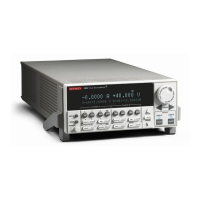
